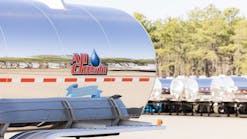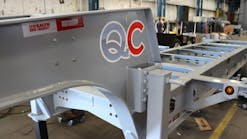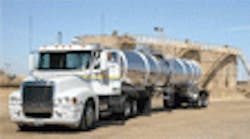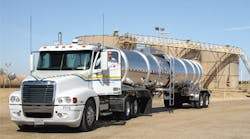Gazelle Transportation Inc prospers with technology applications
With maintenance expertise ensuring vehicles will remain road-ready, and the movement toward technological efficiency in place, Gazelle is poised to meet whatever opportunities the future brings.
With A history in maintenance, Ron Lallo, owner of Gazelle Transportation Inc, has always taken an applied approach when it comes to vehicle specifications — and a penchant for the latest technology.
This year, the owner of the Bakersfield, California, petroleum trucking company made the decision to spec all new Freightliner tractors and Heil tank trailers with MeritorWabco stability enhancement systems and is implementing the use of handheld computers with Qualcomm FleetAdvisor program software.
“It took us a couple of years to make the decision for specifying the stability enhancement systems,” Lallo says.
“We have been using the Fleet-Advisor solution for over four years now,” he adds. “We hope to have the OmniVision transition completed by the middle of next year. The fully electronic and automated log functionality FleetAdvisor offered truly made us a more disciplined and safety focused company — and we believe the stability enhancement systems will do the same.”
When spec'ing the power units, Lallo took into consideration that the Gazelle operation for hauling crude oil and heavy residual products ranges along the West Coast and in the Rocky Mountains areas of Colorado and Utah. For the West Coast traffic he ordered Freightliners with Mercedes Benz MBE 4000 engines rated at 455-horsepower, Eaton Fuller 10-speed transmissions, 12,000-pound Meritor steer axles, Fontaine fifthwheels, and Accuride aluminum wheels. Gazelle also installs STAC Inc Thermaflow hydraulics to power the truck-mounted product pumps.
However, with the more rugged performance required for the mountainous Colorado and Utah regions, Lallo chose Detroit Diesel Series 60 engines with 470/515 horsepower, 18-speed Eaton Fuller transmissions, and 14,000-pound Meritor steer axles.
As for other tractor specifications, Gazelle runs Airliner suspensions, MeritorWabco antilock brake systems, Fontaine fifthwheels, and Michelin tires.
In addition to the tractors, Gazelle uses Freightliner and Heil truck and trailer combinations to haul products in the Rocky Mountain region. The trucks have Detroit Diesel 470/515 horsepower engines, Eaton Fuller 10-speed transmissions, and 14,600-pound steer axles.
Vehicle knowledge
Lallo's savvy of vehicle specification and maintenance was formed as a teenager when he first began work as a mechanic for a Peterbilt dealer in Medford, Oregon. While working on tractors, Lallo began to think about operating his own company. Although he didn't know it at the time, those mental meanderings were going to find a home when the owner, Jerry Eiler, of a trucking company in Medford offered him a job. The decision to join Eiler proved to be one of the best the young man would make in his career.
Eiler took him under his wing and before long Lallo found himself in Bakersfield as maintenance director at Gazelle, a company Eiler had founded to haul petroleum products. Lallo was soon promoted to general manager of the company that at that time was hauling hazardous wastes and fuels for the oil and gas industry.
“I found that I loved that part of the business,” says Lallo of the management responsibilities. However, the road to success wasn't without some potholes. Almost immediately after Lallo took over management, one of the two major refinery customers closed down.
Perhaps Lallo's youth coupled with enthusiasm fired his ambition and determination, but whatever the reason he soon had the company back on its feet. By 1997 and at the age of 25, Lallo had become a part owner. During that time, the company opened a terminal in Coalinga, California, to handle a growing crude oil service. In 2004 Lallo acquired Gazelle from his mentor.
The first year under Lallo's ownership, the company brought in $5.5 million. When the 2008 revenue report is final, the total is expected to top $17 million.
“A pipeline was constructed between Bakersfield and Los Angeles in the 1990s,” Lallo recalls. “That was when we discovered our niche hauling crude oil. Later, we saw energy growth in the Rocky Mountains area and we chased it.”
At first, Gazelle hauled crude from the Rocky Mountains oil fields and then was offered an opportunity in the region where gas exploration and production generated condensate. In 2005, Lallo purchased a trucking company in Vernal, Utah, that was hauling the gas byproduct and expanded the service.
Today, Gazelle operates along the West Coast to Northeastern Utah and Colorado and into the Midwest with terminals in Bakersfield, Santa Maria, Coalinga, California; Vernal, Utah; and Denver and Rifle, Colorado. A new 10,000-square-foot terminal and shop facility has just been opened in Naples, Utah. Five acres have been purchased in Debeque, Colorado, with plans on the drawing board for another terminal and a commercial repair center.
Driver retention
With the terminals strategically located, they make it possible for most drivers to be home after their assignments are completed, which improves retention, says Brian Erquhart, safety and human resources manager.
Although being home on a regular basis is a plus for drivers, they still have driving challenges. Along the West Coast, drivers have to face traffic snarls while in the Rocky Mountains area they are contending with Mother Nature's bipolar moods. Temperature extremes in the Utah area that Gazelle serves varies from 100 degrees in the summer to 30 degrees below zero in the winter.
In a Rocky Mountains remote region on primitive roads, drivers may spend the entire shift on one trip, particularly if they are stopping to chain wheels. Winter snow gives way to thaw, which increases the road muck. The weather in that area has a tendency to change without warning. If it's not snow threatening the road conditions leading to the well sites, it's rain adding its impact.
“Our drivers work in extreme heat and cold,” says Richard Torres. “Because they are going to so many locations out there, they have to develop a keen sense for a wide range of directions. They look for any marker to find their way around.”
Contrast those conditions to the West Coast and one finds that despite the traffic congestion, some drivers, who usually are transporting product on familiar routes, will be able to complete as many as seven deliveries a shift from well sites to refineries or pipeline pump stations. Gazelle dedicates two drivers per tractor in a slip-seat arrangement in order to expedite the service.
Electronic equipment
With the varying logistics involved in the Gazelle operation, it's not surprising that choosing electronic equipment to ease the situation proved successful. All drivers are dispatched 24/7 from Bakersfield by Kathy Fendrick, dispatch supervisor, and Andrew Greeson, Yolanda Padilla, and Aaron Watkins. Dispatchers communicate with most of the drivers through AT&T cell phones and fax bills of lading to their individual terminals. A few drivers in remote areas of the Rocky Mountains regions have satellite phones. Driver logs are automated by the Qualcomm FleetAdvisor software.
Drivers typically complete their runs and telephone their slip-seat partners to notify them when returning to the terminal so that the partners can be ready to take over the wheel.
Driver training
When new drivers are recruited they must be at least 25 years old with two years experience and hold commercial driver licenses (CDL) with tank, hazmat doubles and triples certification. The training program covers company policies, Department of Transportation regulations, defensive driving, and hazardous materials handling. In addition, trainees receive instruction for handling longer vehicles for the doubles and truck-and-trailer combinations the carrier uses.
Drivers typically undergo training either in Bakersfield or at the terminals in the Rocky Mountains region, but plans are underway to consolidate the classroom program in Bakersfield. Special in-cab training is required for drivers who will be negotiating the Colorado and Utah terrain, as well as personal safety issues involving dehydration prevention in the summer heat and cold protection in the winter.
Gazelle's driver safety incentive program includes a driver of the year award and a quarterly safety bonus. To qualify for the awards, drivers can have no driving violations, spills, or accidents. The awards also are based on revenue generated.
The carrier has won numerous safety awards, including the 2004 California Trucking Association Board of Directors Grand Trophy Fleet Safety Award. Gazelle was named twice to the National Tank Truck Carriers Safety Improvement Contest list.
Tank trailers
In addition to the Freightliner tractors supplied by Bakersfield Truck Center, drivers are handling Heil International tank trailers sold through Sterling Tank and Equipment LLC.
“Ron has added MeritorWabco roll stability to his newest tank trailers,” notes Steven Traversi at Sterling Tank. “He is probably one of the first crude oil carriers to do this. He also specifies Roper hydraulic drive four-inch product pumps for all of his semitrailers, and he uses a sophisticated Garnet overfill protection system that shuts down the pump when the tank is full, which is a very good safety feature.”
The newest Heil DOT407 tank trailers have 8,820-gallon capacity and are equipped with Girard pressure-relief vents, Civacon air-operated vapor vents, Betts internal valves, and Knappco domelids. Running gear includes Hendrickson Intraax air suspension, MeritorWabco antilock brake system, and Holland landing gear.
Gazelle's 4,800-gallon truck-mounted tanks also are supplied by Heil International, as are the 5,500-gallon pup trailers and 9,000-gallon semitrailers.
A few new DOT406 tank trailers are going into service when needed. The four-compartment tank trailers have Civacon dry disconnect couplings, Betts gate valves, and Scully overfill protection system. Some of the DOT406 trailers have Michelin X One wide single tires.
“We need a variety of tank trailers to meet the needs of our customers,” Lallo says.
As might be expected, Lallo hasn't lost his enthusiasm for vehicle maintenance. A pristine three-bay and well-organized shop indicates the owner's interest in the work. Keeping vehicles in good condition is the focus for the Gazelle maintenance department led by Ryan Miller.
Preventive maintenance schedules for the tractors include an A-level for lube and inspection at 7,500 miles, B-level for lube and oil change at 15,000 miles, and C-level for rebuilding air dryers, inspecting turbo, and adjusting valves at 100,000 miles.
As most managers know, a good tire program can ease the budget's bottom line, so Lallo developed a plan that calls for moving tractor steer tires at a tread depth of 12.32 to the tank trailers before eventual retreading.
Tank trailer maintenance includes an inspection and chassis lube every 45 days. “We can perform most maintenance and repairs, except those for tank trailers that require a code shop,” says Miller. “We really try not to send anything out unless we have to.”
As for the future, Lallo projects more opportunity for growth in the oil and gas sector. “If it's a liquid, we want to haul it,” he says. “But we want growth with maximum profitability. To achieve that, we are focusing on internal efficiency that the addition of the OmniVision program will enhance. Another way we are improving efficiency is with the use of the Garnet electronic level gauge that provides us with precise levels of product.”
Lallo adds that he has ordered six new vacuum trailers from Troxell Trailer Manufacturing for hazmat waste hauling in addition to the DOT406 tank trailers he plans to bring into service in the near future.










